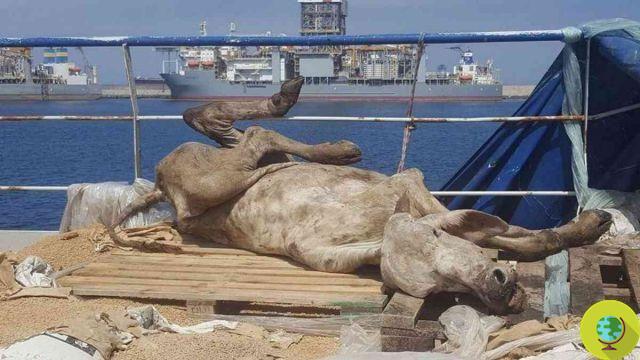An interesting report by the French NGO Robin des Bois highlights a terrible aspect of animal exports.
He is about to end up run over, his mother saves himHuge ships used to transport farm animals are an attractive option for criminals who smuggle drugs and weapons. And people
Behind the agonizing transport of live (or already dead) animals lies something incredible. Something shady and obscene. Gruesome scenes that, one after the other, show a dark side that no one would want to see. Yet, they are there, meaning that nothing is never what it seems. And that sometimes there is something rotten under another rotten.
An interesting report by the French NGO Robin des Bois and taken up in these days by an article in The Guardian highlights an aspect of animal exports that not everyone was familiar with. Two le livestock carriers in the viewfinder and hundreds i decaying animal corpses in the midst of which, between urine and feces, the Spanish police searched for smuggled drugs.
Read also: The horror of animals transported from Spain to the Middle East: a sea voyage towards death
That's right: drugs, but also weapons and people. Smugglers among the ferrymen of bodies to be slaughtered.
On the first ship, the Neameh, a ramshackle ship built in 1979 and 109 meters long. Coming from Cartagena de Indias (Colombia), she was headed to the Egyptian port of Damietta. Stopped last year in the Spanish port of Algeciras on suspicion of smuggling cocaine from Colombia, many of the approximately 4 cattle on board were found dead or dying as they lay in their own excrement. The stench was so strong that even the drug dogs couldn't help.
The second ship, the FM Spiridon, of 1973 and 97 meters long and which had left Cartagena de Indias for the Egyptian port. With about 5 thousand head of cattle on board, she was also stopped in 2020 in the Canary Islands and always with the suspicion that she was used to smuggle drugs. Inside, Spanish police found a scene of deplorable animal conditions, corpses and sick or dying animals. Once again, a pervasive stench filled the ship and no drugs were found.
In both cases, in short, the drug was never found, but the authorities and experts know it for sure: the smuggling of drugs and more on ships and trucks carrying livestock has always been and still remains. an increasingly attractive option for traffickers.
Nearly 2 billion farm animals are transported around the world each year in a trade worth more than $ 20 billion annually.
Maritime transport ships are the Pandora's box of international smuggling - says Charlotte Nithart, director of the French NGO Robin des Bois, which specializes in maritime safety and pollution, smuggling, poaching and animal welfare. Livestock ships, she says, are "unrivaled" in their usefulness for illegally transporting dubious goods, such as narcotics, weapons, counterfeit goods and wildlife by-products.
These livestock cargo ships are a disgrace to Europe
These livestock cargo ships are a disgrace for Europe: garbage ships, they are used to transport animals over incredible distances and in appalling conditions.
Posted by Loopsider on Friday, July 2, 2021
The benefits of livestock ships, says Nithart, include the daunting logistics of where to put animals if a ship is hijacked, the size of the ships, their poorly paid crews, and the global reach, covering routes from Colombia and Brazil to the 'Europe and eastern Mediterranean ports, including those of Turkey, Egypt, Lebanon and Jordan.
Other benefits, says Maria Boada, a live animal transport specialist with the Animal Welfare Foundation, include the difficulty of looking for enclosures full of live animals and strong odors.

© The ship FMSpiridon / Cadena SER
The exceptional measures, in short, which would make it more difficult to inspect a ship for livestock and which include additional health checks and requirements if the animals are unloaded, as well as the existing "complexity" of searching any ship suspected of drug trafficking, make everything easier for smugglers.
Those in charge will continue to dig into this rot, but this is good: in this way the state in which thousands of animals travel from one continent to another, between mountains of excrement and various corpses, is brought to light.
Source: Robin des Bois / The Guardian
Read also:
- The UK bans the export of live animals for slaughter
- The odyssey of hundreds of cattle stranded on a ship for two months, without enough water or food
- Billions of animals suffer every day across Europe, but now we have the historic opportunity to change farms


























